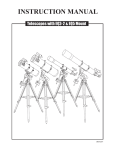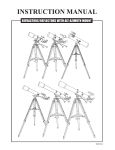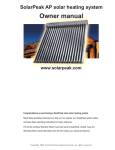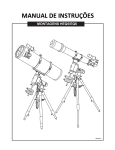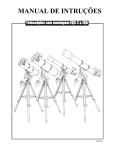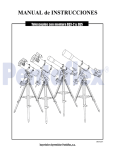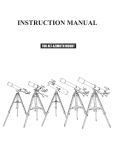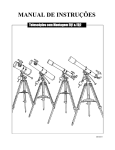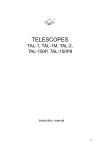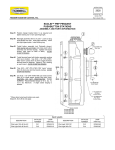Download Waves H-EQ Instruction manual
Transcript
Telescopes with HEQ5 & EQ6 Mount 110203V1 A B C REFRACTOR D E F G H I J 17 K 16 L 15 14 13 1 N M 2 3 4 12 11 A B 5 10 C 6 D E F 9 G 8 7 H I J 17 HEQ5 A. Dust Cap/Mask EQ6 16 15 A. Dust Cap/Mask (Remove before Viewing) (Remove before Viewing) B. Sun Shade C. Objective Lens Location D. Adjustable Lens Cell E. Telescope Main Body F. Piggyback Bracket G. Tube Ring H. Finderscope I. Finderscope Bracket J. Alignment Screw K. Eyepiece L. Diagonal M. Focus Tube N. Focus Knob B. Sun Shade C. Objective Lens Location D. Adjustable Lens Cell E. Telescope Main Body F. Piggyback Bracket G. Tube Ring H. Finderscope I. Finderscope Bracket J. Alignment Screw K. Eyepiece L. Diagonal M. Focus Tube N. Focus Knob 1. R.A. Lock Lever 2. Polarscope Holder (not shown) 3. Latitude Scale 4. Altitude Adjustment T-bolts 5. Azimuth Adjustment Knob 6. Accessory Tray 7. Height Adjustment Clamp 8. Tripod Leg 9. Hand Control 10. Counterweight Rod 11. Counterweight 12. Counterweight Thumb Screw 13. Counterweight Rod Lock Knob 14. Dec Setting Circle 15. Dual Axis Motor Drives (not shown) 16. Dec Lock Lever 17. Mounting Plate 1. R.A. Lock Lever 2. Polarscope Holder (not shown) 3. Latitude Scale 4. Altitude Adjustment T-bolts 5. Azimuth Adjustment Knob 6. Accessory Tray 7. Tripod Leg 8. Height Adjustment Clamp 9. Hand Control 10. Counterweight Rod 11. Counterweight 12. Counterweight Thumb Screw 13. Counterweight Rod Lock Knob 14. Dual Axis Motor Drives (not shown) 15. Dec Setting Circle 16. Dec Lock Lever 17. Mounting Plate K 14 1 2 13 12 3 4 11 5 10 6 9 7 8 2 N M L E REFLECTOR F G H I D HEQ5 J K C L B A 17 EQ6 16 E F 15 G 1 14 2 13 12 3 D 4 C H I J 5 11 K L B 10 A 6 9 17 7 HEQ5 A. B. C. D. E. F. G. H. I. J. K. L. Eyepiece Focus Tube Focus Knob Dust Cap/Maks (Remove before viewing) Finderscope Finderscope Bracket Alignment Screw Tension Adjustment Screw Piggyback Bracket Tube Rings Telescope Main Body Primary Mirror Location 1. R.A. Lock Lever 2. Polarscope Holder (not shown) 3. Latitude Scale 4. Altitude Adjustment T-bolts 5. Azimuth Adjustment Knob 6. Accessory Tray 7. Tripod Leg 8. Height Adjustment Clamp 9. Hand Control 10. Counterweight Rod 11. Counterweight 12. Counterweight Thumb Screw 13. Counterweight Rod Lock Knob 14. Dec Setting Circle 15. Dual Axis Motor Drives (not shown) 16. Dec Lock Level 17. Mounting Plate EQ6 A. B. C. D. E. F. G. H. I. J. K. L. 16 Eyepiece Focus Tube Focus Knob Dust Cap/Maks (Remove before viewing) Finderscope Finderscope Bracket Alignment Screw Tension Adjustment Screw Piggyback Bracket Tube Rings Telescope Main Body Primary Mirror Location 8 15 1 2 14 13 3 12 4 11 5 10 1. R.A. Lock Lever 2. Polarscope Holder (not shown) 3. Latitude Scale 4. Altitude Adjustment T-bolts 5. Azimuth Adjustment Knob 6. Accessory Tray 7. Tripod Leg 8. Height Adjustment Clamp 9. Hand Control 10. Counterweight Rod 11. Counterweight 12. Counterweight Thumb Screw 13. Counterweight Rod Lock Knob 14. Dual Axis Motor Drives (not shown) 15. Dec Setting Circle 16. Dec Lock Level 17. Mounting Plate 9 6 7 8 3 TABLE OF CONTENTS Assembling Your Telescope 5 Tripod set up Mount assembly Telescope assembly Finderscope assembly Eyepiece assembly Hand control installation 5 5 6 6 7 7 Operating Your Telescope 8 8 8 9 9 10 10 10 15 15 16 20 Aligning the finderscope Balancing the telescope Operating the HEQ5/EQ6 mount Using the hand control Using the optional Barlow lens Focusing The polarscope Tracking celestial objects Setting circles Pointing your telescope Choosing the appropriate eyepiece Observing the Sky 21 Sky conditions Selecting an observing site Choosing the best time to observe Chooling the telescope Adapting your eyes 21 21 21 21 21 Proper Care for Your Telescope 22 Collimating a Newtonian reflector Collimating a refractor (with the adjustable objective-lens cell) Cleaning your telescope Before you begin This instruction manual is applicable to all the models with the HEQ5 or EQ6 mount. Take a moment to find the model closest to your telescope on p.2 and p.3. Follow the instructions for your specific model in the manual. Read the entire instructions carefully before beginning. Your telescope should be assembled during daylight hours. Choose a large, open area to work to allow room for all parts to be unpacked. 22 24 24 Caution! NEVER USE YOUR TELESCOPE TO LOOK DIRECTLY AT THE SUN. PERMANENT EYE DAMAGE WILL RESULT. USE A PROPER SOLAR FILTER FOR VIEWING THE SUN. WHEN OBSERVING THE SUN, PLACE A DUST CAP OVER YOUR FINDERSCOPE TO PROTECT IT FROM EXPOSURE. NEVER USE AN EYEPIECETYPE SOLAR FILTER AND NEVER USE YOUR TELESCOPE TO PROJECT SUNLIGHT ONTO ANOTHER SURFACE, THE INTERNAL HEAT BUILD-UP WILL DAMAGE THE TELESCOPE OPTICAL ELEMENTS. ASSEMBLING YOUR TELESCOPE TRIPOD SET UP Fig. 1 ASSEMBLING THE TRIPOD LEGS (Fig.1) 1) Slowly loosen the height adjustment clamp Fig. 2. and gently pull out the lower section of each tripod leg. Tighten the clamps to hold the legs in place. 2) Spread the tripod legs apart to stand the tripod upright. 3) Place a carpenter's level or bubble level on the top of the tripod legs. Adjust the height of each tripod leg until the tripod head is properly leveled. Note that the tripod legs may not be at same length when the equatorial mount is level. ATTACHING MOUNT TO TRIPOD LEGS (Fig. 2) 1) Align metal dowel on the tripod head with the gap between the azimuth adjustment knobs underneath the mount. 2) Push the primary locking shaft up against the mount and turn the knurled knob underneath to secure mount to tripod. Fig. 3 ATTACHING THE ACCESSORY TRAY (Fig. 3) 1) Slide the accessory tray along the primary locking shaft until it pushes against the tripod legs. 2) Secure with the washer and locking knob. Note: Loosen the azimuth adjustment knobs if mount does not fit into tripod head completely. Retighten knobs to secure. MOUNT ASSEMBLY Fig. 4 EQ-6 INSTALLING THE COUNTERWEIGHTS (Fig. 4, 5) 1) Loosen the counterweight rod lock knob and gently pull out the counterweight rod. Re-tighten the lock knob to secure the counterweight rod in place. 2) Unscrew the threaded cap from the end of the counterweight rod. 3) Locate the counterweights and slide them halfway along the counterweight rod. Tighten the counterweight thumb screws to secure. 5) Replace the cap on the end of the counterweight rod. (diagram applicable to both mounts) 5 Fig. 5 TELESCOPE ASSEMBLY Fig. 7 ATTACHING THE MOUNTING PLATE (Fig.6) Fig. 6 1) Position the mounting plate on the mounting bracket. 2) Secure by tightening the two locking screws. ATTACHING THE TUBE RINGS (Fig.7) EQ-6 (diagram applicable to both mounts) 1) Remove the telescope tube assembly from its plastic packaging. 2) Remove the tube rings from the telescope by releasing their thumb nuts and opening their hinges. 3) Using the bolts provided, fasten the tube rings to the mount with the 10mm wrench provided. TELESCOPE ASSEMBLY Fig. 8 ATTACHING THE TELESCOPE MAIN TUBE TO THE TUBE RINGS (Fig.8) 1) Remove the telescope tube from the paper covering. 2) Find the center of balance of the telescope tube. Place this in between the two tube rings. Close the hinges around the telescope and fasten securely by tightening the thumb nuts. FINDERSCOPE ASSEMBLY (for reflectors) Fig.9 ATTACHING THE FINDERSCOPE BRACKET (Fig. 9,10,11) Fig.10 Fig.11 1) Locate the finderscope bracket. Carefully remove the rubber-o-ring from the finderscope bracket. 2) Position the o-ring into the groove located approximately half-way along the finderscope tube. 3) Locate the finderscope optical assembly. 4) Slide the finderscope bracket into the rectangular slot and tighten the screw to hold the mount in place. 5) Position the finderscope into its bracket by sliding it backwards until the rubber o-ring seats in the finderscope mount. FINDERSCOPE ASSEMBLY (for refractors) Fig.12 Fig.13 ATTACHING THE FINDERSCOPE (Fig.12,13,14) 1) Locate the finderscope bracket. Carefully remove the rubber-o-ring from the finderscope bracket. 2) Position the o-ring into the groove located approximately half-way along the finderscope tube. 3) Locate the finderscope optical assembly. 4) Slide the finderscope bracket into the rectangular slot and tighten the screw to hold the mount in place. 5) Position the finderscope into its mount by sliding it backwards until the rubber o-ring seats in the finderscope mount. 6 Fig.14 EYEPIECE ASSEMBLY (for reflectors) Fig.15 Fig.16 INSERTING THE EYEPIECE (Fig.15, 16) 1) Unscrew the thumbscrews on the end of the focus tube to remove the black plastic end-cap. 2) Insert the desired eyepiece and secure it by retightening the thumbscrews. EYEPIECE ASSEMBLY (for refractors) INSERTING THE EYEPIECE (Fig.17) Fig.17 1) Loosen the thumbscrew on the end of the focus tube. 2) Insert the diagonal into the focus tube and re-tighten the thumbscrew to hold the diagonal in place. 3) Loosen the thumbscrews on the diagonal. 4) Insert the desired eyepiece into diagonal and secure by re-tightening the thumbscrews. HAND CONTROL INSTALLATION (for HEQ5) CONNECTING THE HAND CONTROL (Fig.19) POWERING THE EQ6 MOTORS (Fig.18) 1) Insert eight "D" cell batteries into the battery case. 2) Plug the DC power cord from battery case into the DC 12V outlet on the side of the mount. 1) The EQ6 hand control has a phone type connector. Plug the phone jack connector into the outlet on the mount. Push the connector into the outlet until it clicks into place. Fig.18 Fig.19 HAND CONTROL INSTALLATION (for EQ6) CONNECTING THE HAND CONTROL (Fig.21) Fig.20 DC Po we r 1) Insert eight "D" cell batteries into the battery case. 2) Plug the DC power cord from battery case into the DC 12V outlet on the side of the mount. 12V POWERING THE EQ6 MOTORS (Fig.20) 1) The EQ6 hand control has a phone type connector. Plug the phone jack connector into the outlet on the mount. Push the connector into the outlet until it clicks into place. Fig.21 7 OPERATING YOUR TELESCOPE Aligning the finderscope Fig.a Fig.a-1 These fixed magnification scopes mounted on the optical tube are very useful accessories. When they are correctly aligned with the telescope, objects can be quickly located and brought to the centre of the field. Alignment is best done outdoors in day light when it's easier to locate objects. If it is necessary to refocus your finderscope, sight on an object that is at least 500 yards (metres) away. Loosen the locking ring by unscrewing it back towards the bracket. The front lens holder can now be turned in and out to focus. When focus is reached, lock it in position with the locking ring (Fig.a). 1) Choose a distant object that is at least 500 yards away and point the main telescope at the object. Adjust the telescope so that the object is in the centre of the view in your eyepiece. 2) Check the finderscope to see if the object centred in the main telescope view is centred on the crosshairs. 3) Adjust the two small screws to centre the finderscope crosshairs on the object (Fig.a-1). Balancing the telescope A Telescope should be balanced before each observing session. Balancing reduces stress on the telescope mount and allows for precise control of micro-adjustment. A balanced telescope is specially critical when using the optional clock drive for astrophotography. The telescope should be balanced after all accessories (eyepiece, camera, etc.) have been attached. Before balancing your telescope, make sure that your tripod is balanced and on a stable surface. For photography, point the telescope in the direction you will be taking photos before performing the balancing steps. R.A. Balancing Fig.b 1) For best results, adjust the altitude of the mount to between 15º and 30º if possible, by using the altitude adjustment T-bolt. It is important to loosen one T-bolt before tightening the other. Overtigtening can cause the bolts to bend or break. 2) Slowly unlock the R.A. and Dec. lock knobs. Rotate the telescope until both the optical tube and the counterweight rod are horizontal to the ground, and the telescope tube is to the side of the mount (Fig.b). 3) Tighten the Dec. lock knob. 4) Move the counterweights along the counterweight rod until the telescope is balanced and remains stationary when released. 5) Tighten the counterweight thumb screws to hold the counterweights in their new position. N (diagram applicable to both mounts) Dec. Balancing The R.A. balancing should be done before proceeding with Dec. balancing. 1) For best results, adjust the altitude of the mount to between 60º and 75º if possible. 2) Release the R.A. lock knob and rotate around the R.A. axis so that the counterweight rod is in a horizontal position. Tighten the R.A. lock knob. 3) Unlock the Dec. lock knob and rotate the telescope tube until it is parallel to the ground. 4) Slowly release the telescope and determine in which direction it rotates. Loosen the telescope tube rings and slide the telescope tube forward or backward in the rings until it is balanced. 5) Once the telescope no longer rotates from its parallel starting position, re-tighten the tube rings and the Dec. lock knob. Reset the altitude axis to your local latitude. 8 Fig.c Operating the HEQ5/EQ6 mount The EQ6 mount has controls for both conventional altitude (up-down) and azimuthal (left-right) directions of motion. Use the altitude adjustment T-bolts for altitude adjustments. The two T-bolts work against each other to move the mount in altitude or azimuth. It is important to loosen one T-bolt before tightening the other. Overtigtening can cause the bolts to bend or break. The azimuthal axis is changed by the two azimuth adjustment knobs located near the tripod head. These provide fine-adjustment of azimuth for polar aligning (Fig.c). In addition, this mount has direction controls for polar aligned astronomical observing. These directions use Right Ascension (east/west) and Declination (north/south) axis. There are two options to move the telescope in these directions: For large and quick movement, loosen the R.A. lock lever or the Dec. lock lever (Fig.c-1). For fine adjustments, use the motor drive hand control (see "Using the Hand Control"). Altitude adjustment EQ-6 Azimuth adjustment (This diagram is applicable to both mounts) Fig.c-1 HEQ5 Dec. adjustment R.A. adjustment There are three numerical scales on this mount. The lower scale on the side of the mount is used for polar alignment of the telescope to your local latitude. The R.A. (Right Ascension) scale measures hour angle and is adjustable to your local meridian. The declination scale is located near the top (EQ6) or the counterweight rod (HEQ5) of the mount. Latitude scale Using the hand control The N/Off/S switch acts as a power switch as well as controller for the directions of the motors. The "N" position allows R.A. motor to track for the Northern Hemisphere observations and the "S" position is suitable for the Southern Hemisphere (Fig.d). When the EQ6 Hand Control is turned on and all buttons are depressed, the R.A. motor will rotate at the proper speed to compensate for the earth's rotation. The Dec. axis does not automatically rotate. When the mount is correctly polar aligned, you only need to turn the R.A. slow-motion to follow or track objects as they move through the field. The Dec. control is not needed for tracking. The four push buttons control the directions of the motors. The updown buttons control the declination motor while the left-right buttons change the R.A. axis. Fig.d Power/direction switch R.A control The rate switch allows for changes to the speed rate of the motors buttons from high speed slew rate (16X or fast) to slow micro-adjustment (2X) and the speed in between (8X). When the rate switch is set on "2X", pressing the right R.A. button will rotate the telescope forward at Fig.d-1 twice the tracking speed or approximately ½º per minute. The left R.A. button stops all motion and allows stars to drift by at their normal rotation rate of approx. ¼º per minute. The "8X" setting moves the telescope forward at 8 times the tracking rate and the left button moves the telescope backwards at 7 times the tracking rate. The "Fast" or "16X" setting allows forward at 16 times the tracking rate and the left button moves the telescope backwards at 15 times the tracking rate. When the reverse switches on the side of the hand control are set on "REV" (Fig.d-1), the four push buttons act in reverse. For example, when the upper switch is set to "REV", pressing the left R.A. button moves the telescope forward, and the right R.A. button moves the telescope backwards. 9 Rate switch 2X 8X Fast N OFF S (or 16X) Dec control buttons Dec R.A R.A Dec RA REV DEC REV Reverse switches Using the optional Barlow lens Fig.e A Barlow is a negative lens which increases the magnifying power of an eyepiece, while reducing the field of view. It expands the cone of the focussed light before it reaches the focal point, so that the telescope's focal length appears longer to the eyepiece. Eyepiece Barlow Diagonal The Barlow is inserted between the focuser and the eyepiece in a reflector, and usually between the diagonal and the eyepiece in a refractor or a maksutov (Fig.e). With some telescopes, it can also be inserted between the focuser and the diagonal, and in this position it gives even greater magnification. For example, a 2X Barlow when inserted after the diagonal can become 3X when placed in front of the diagonal. (Refracting Telescopes and Maksutovs) Barlow In addition to increasing magnification, the benefits of using a Barlow lens include improved eye relief, and reduced spherical aberration in the eyepiece. For this reason, a Barlow plus a lens often outperform a single lens producing the same magnification. However, its greatest value may be that a Barlow can potentially double the number of eyepieces in your collection. Eyepiece (Reflecting Telescopes) Focusing Fig.f Slowly turn the focus knobs under the focuser, one way or the other, until the image in the eyepiece is sharp (Fig.f). The image usually has to be finely refocused over time, due to small variations caused by temperature changes, flexures, etc. This often happens with short focal ratio telescopes, particularly when they have not yet reached outside temperature. Refocusing is almost always necessary when you change an eyepiece or add or remove a Barlow lens. On some focusers, there is a tension adjustment. Over-tighten this may damage the rack and pinion assembly. (Refracting Telescopes) The Polarscope The pole-finder telescope supplied with the HEQ5 and EQ6 Mount can be used for accurate polar alignment. This method of polar alignment is sufficient for virtually all visual use of the telescope. To use the polarscope, the declination axis must be rotated such that the hole in the shaft is in front of the polar scope. This allows the user to see all the way through the Right Ascension shaft. If possible, this procedure should be carried out while the telescope and counterweights are on the mount. This prevents the mount from becoming misaligned when the load on the tripod is changed. Leveling the tripod will make it easier to use the Azimuth and Altitude adjustments on the mount when trying to center the stars in the polar scope. The tripod can be made level by using a bubble level or carpenter's level. 10 (Reflecting Telescopes) Fig.g Pow er DC 12V Remove the caps from the upper and lower ends of the Right Ascension (R.A.) axis (Fig.g). Looking through the polar scope, lines should be seen super-imposed on the sky. If these lines are not visible, shine a red flashlight across the upper end of the RA axis to illuminate the top end of the pole finder. Figure b shows the view through the pole finder. Line drawings representing the Big Dipper and Cassiopeia are used for the Northern Hemisphere. The third line drawing represents Octans and is used for the Southern Hemisphere. The circle in the center of the field indicates the path Polaris makes around the North Celestial Pole. Simple Methods Northern Hemisphere ia Fig.g-1 Octans Polaris NCP Big Dip er p By using the line drawings of the Big Dipper and Cassiopeia, the RA shaft can be rotated so the view in the pole finder is similar to the view of the sky. This can be done by using one eye to look through the pole finder while using the other eye to look at the sky. This procedure takes some practice. Adjust the mount in Altitude and Azimuth, until Polaris is in the small circle on the line in the pole finder (Fig.g-1). The polar alignment is now complete. This should get the mount's R.A. axis within 5 arc-minutes of the celestial pole. (diagram applicable to both mounts) e C assi o p There is only one easily visible star near the North Celestial Pole. This star is Polaris. The rest of the stars in Ursa Minor are around Magnitude 5 and require very dark skies to become visible. Since Polaris is not exactly on the North Celestial Pole, the telescope's R.A. axis must be offset from Polaris by a small amount in the correct direction. Place Polaris here Southern Hemisphere Northern Hemisphere Fig.g-2 Place the four stars in the Asterism here Octans Polaris NCP Big Dip p er Southern Hemisphere 11 C assi o a p ei There is a 4-star pattern in the polar scope, which resembles the bucket of the Big Dipper. In the Southern Hemisphere, there is an Asterism in Octans, which has this shape. By rotating the R.A. axis and by adjusting the altitude and azimuth of the mount, the four stars in the Asterism can be placed in the circles in the Pole Finder (Fig.g-2). This procedure can be somewhat difficult in the city because all four of these stars are fainter than Magnitude 5. Fig.g-3 HEQ5 Accurate method for the Northern Hemisphere Rotate the Date Circle on the Pole Finder so the index mark is lined up with the 'zero' on the longitude indication (Fig.g-3). Now rotate the telescope in RA axis so the pointer at the lower end of the mount points to today's date on the Date Circle (March 4th in this case) (Fig.g-4). Tighten the RA lock knob to lock the RA axis in place. Loosen the thumb screw on the RA setting circle and rotate the RA Circle so the pointer points to the current time. The upper set of numbers apply to viewing in the Northern Hemisphere, while the numbers below them apply to viewing in the Southern Hemisphere. Tighten the thumb screw to lock the RA Circle in place and rotate the telescope around the RA axis so the pointer points to 0 hours, 0 minutes (see Fig.e for HEQ5, Fig.g for EQ6). Now use the Altitude and Azimuth adjustments to align Polaris in the Polarscope (Fig.g-6). Setscrew 23 1 22 2 21 20 4 3 4 0 0 10 20 W 20 10 Pointer 2 1 12 E 1 23 0 Date Circle Index Mark EQ6 Pointer Fig.g-5 12 20 10 E Set screw 1 0 10 20 W Date Circle 2 RA setting circle Index Mark 20 3 22 2 21 23 1 1 23 0 2 22 3 21 4 20 5 19 Fig.g-4 pointer RA Locking knob HEQ5 21 20 4 3 23 1 22 2 2 E 20 10 1 23 0 2 4 3 0 10 20 W 4 Octans Polaris NCP C assi o p eia Fig.g-6 EQ6 Big Dip p er 2 3 10 0 10 20 W E 20 Put Polaris in this circle 12 4 Fig.g-7 Polarscope alignment NCP p er Place Polaris here Fig.g-8 To move the reticule, adjust the three small setscrews on the polarscope (Fig.g-8). Make small adjustments by moving only two of the screws at a time. Adjust the screws to move Polaris half the distance back to the center of the reticule (Fig.g-9). This is because Polaris started in the center of the reticule. By rotating the mount 180 degrees, Polaris moved exactly twice the distance between the center of the reticule and the center of rotation. The center of rotation lies midway between the center of the reticule and the new position of Polaris. Do not turn any of the setscrews more than one-quarter turn at a time or the reticule will disengage from the setscrews. Do not over-tighten these screws too much or the stress could fracture the reticule. Now re-center Polaris under the cross in the middle of the reticule using the Azimuth and Altitude adjustments. Repeat the entire procedure until Polaris remains in the center of the reticule when the mount is rotated about the R.A. axis. With some practice, you should be able to align the reticule with the R.A. axis to within about 2 arcminutes. You should never have to make this adjustment again, unless the polar scope has been dropped, disassembled, or if the polar scope is to be used on another mount. C assi o p Polaris Dip Locate Polaris and place it in the center of the polarscope by adjusting the Altitude and Azimuth of the mount. Place Polaris directly under the cross in the center of the reticule (Fig.g-7). Rotate the mount one half turn about the R.A. axis. Polaris should remain under the cross in the center of the reticule. If it does not, the reticule is not centered on the R.A. axis of the mount. Octans Big The optical axis of the polarscope is already aligned with the rotation axis of the mount. The optical axis of the polar scope can not be adjusted. This is set permanently at the factory. The reticule in the polar scope must be centered on the optical axis of the polar scope. When this is true, the reticule in the polar scope will be parallel to the rotation axis of the mount. If this is not the case, accurate polar alignment will not be possible. eia The Reticule 12 E 20 10 1 0 10 20 W 2 adjust these screws (diagram applicable to both mounts) Fig.g-9 If Polaris drifted to here If Polaris is not visible from your area, a distant object such as the top of a telephone pole, or a distant mountaintop can be used. These objects are larger than the image of a star, so they will not provide as accurate an alignment, but they will not move during this alignment procedure. Place Polaris here (half the distance) 13 C assi o p eia Fig.g-10 Unlock the RA locking knob. Rotate the telescope around the RA axis so the reticule is as shown in Fig g-10. Retighten the RA locking knob to lock the RA axis in this position. In this position, Polaris is in transit - it is at its highest point in the sky. Unlock the RA setting circle by loosening the set screw. Rotate the RA Circle so the pointer indicates 'zero' and lock the RA Circle. This sets the first of two 'zeros' required for the slide rule. Now rotate the telescope around RA axis so the RA Circle indicates 1h 0m (Fig.g11). Lock the RA axis. Rotate the Date circle so October 10 is indicated (see Fig.g-11 for HEQ5, Fig.g-12 for EQ6 ). At 1:00 AM local time, on October 10, Polaris is in transit anywhere in the world. Rotate the telescope around the RA axis so the RA circle indicates 'zero' and lock the RA axis. The view through the Pole Finder should be the same as before. Loosen the setscrew on the index marker ring. Adjust the index marker ring so the Date circle reads 'zero' on the longitude indication (Fig.g-13). Secure the ring by tightening the setscrew. This sets the second of the two zero points. Octans NCP The polar scope in combination with the RA setting circle constitutes a circular slide rule. This slide rule is used to calculate the hour angle of Polaris at your local time anywhere on the planet. On a given day of the year, eg March 30, at a given local time, eg 10:00pm, the hour angle of Polaris is the same, anywhere on the planet. This is an approximation, which is good to about 4 minutes of arc. The index marker represents a 'zero' for the slide rule. If the zero is not set correctly, the calculated hour angle will not be correct. er Polaris The Index Marker B i ig D Make this line vertical Place this circle on the bottom Fig.g-11 Pointer 0 23 1 22 21 3 Set screw 2 1 23 9 8 2 22 3 4 5 19 10 HEQ5 Set screw RA setting circle EQ6 21 3 23 1 21 0 1 23 2 22 3 21 Pointer RA Locking knob Fig.g-13 Fig.g-12 11 12 8 10 Index mark should be here Set screw Rotate this ring (diagram applicable to both mounts) 14 RA setting circle 11 Date circle If the reticule has been re-aligned or the index ring has come loose, this procedure must be carried out again to ensure accurate polar alignment. 9 pp 8 9 10 11 4 20 5 19 6 18 Tracking celestial objects When observing through a telescope, astronomical objects appear to move slowly through the telescope's field of view. When the mount is correctly polar aligned, you only need to turn the R.A. buttons on the hand control to follow or track objects as they move through the field. The DEC. buttons are not needed for tracking. Setting circles The quickest way to find objects is to learn the Constellations and use the finderscope, but if the object is too faint you may want to use setting circles on an equatorial mount. Setting circles enable you to locate celestial objects whose celestial co-ordinates have been determined from star charts. Your telescope must be Polar aligned and the R.A. setting circle must be calibrated before using the setting circles. Fig.h HEQ5 Setscrew 21 20 4 3 23 1 22 2 12 Reading the R.A. setting circle E 1 23 0 20 10 Pointer 2 Northern Hemisphere 4 1 0 0 10 20 W Sorthern Hemisphere The telescope's R.A. setting circle is scaled in hours, from 1 through 24, with small lines in between representing 10 minute increments. The upper set of numbers apply to viewing in the Northern Hemisphere, while the numbers below them apply to viewing in the Southern Hemisphere. (Fig.h). Setting (calibrating) the R.A. setting circle In order to set your Right Ascension circle you must first find a star in your field of view with known coordinates. A good one would be the 0.0 magnitude star Vega in the Constellation Lyra. From a star chart we know the R.A. coordinate of Vega is 18h 36m. Loosen the R.A. and DEC. lock knobs on the mount and adjust the telescope so that Vega is centred in the field of view of the eyepiece. Tighten the R.A. and DEC. lock knobs to lock the mount in place. Now rotate the R.A. setting circle until it reads 18h36m. You are now ready to use the setting circles to find objects in the sky. EQ6 Setscrew 20 3 21 22 2 Northern Hemisphere 23 1 0 1 23 2 22 3 21 4 20 5 19 Southern Hemisphere Finding objects using the setting circles Example: Finding the faint planetary nebula M57; "The Ring" From a star chart, we know the coordinates of the Ring are Dec. 33º and R.A. 18h52m. Unlock the DEC lock knob and rotate your telescope in DEC until the pointer on the DEC setting circle reads 33º. Re-tighten the DEC lock knob. Loosen the R.A. lock knob and rotate the telescope in R.A. until the pointer on the R.A. setting circle reads 18h52m (do not move the R.A. circle). Re-tighten the R.A. lock knob. Now look through the finderscope to see if you have found M57. Adjust the telescope with the hand control until M57 is centred in the finderscope. Now look through the telescope using a low power eyepiece. Centre M57 in the field of view of the eyepiece. If you are familiar with the night sky, it is sometimes convenient to find an object using only the DEC coordinate. Loosen the DEC lock knob and rotate the telescope in DEC until the pointer on the DEC setting circle reads 33º. Re-tighten the DEC lock knob. Now traverse through Lyra in R.A. axis until M57 appears in the field of view. The setting circles will get you close to the object you wish to observe, but are not accurate enough to put it in the centre of your finderscope's field of view. The accuracy of your setting circles also depends on how accurate your telescope is polar aligned. 15 Pointing Your Telescope A German Equatorial mount has an adjustment, sometimes called a wedge, which tilts the mount's polar axis so that it points at the appropriate Celestial Pole (NCP or SCP). Once the mount has been polar aligned, it needs to be rotated around only the polar axis to keep an object centred. Do not reposition the mount base or change the latitude setting. The mount has already been correctly aligned for your geographical location (ie. Latitude), and all remaining telescope pointing is done by rotating the optical tube around the polar (R.A.) and declination axes. A problem for many beginners is recognizing that a polar-aligned equatorial mount acts like an alt-azimuth mount which has been aligned to a celestial pole. The wedge tilts the mount to an angle equal to the observer's Latitude, and therefore it swivels around a plane which parallels the celestial (and Earth's) equator (Fig.i). This is now its "horizon"; but remember that part of the new horizon is usually blocked by the Earth. This new "azimuth" motion is called Right Ascension (R.A). In addition, the mount swivels North(+) and South() from the Celestial Equator towards the celestial poles. This plus or minus "altitude" from the celestial equator is called Declination (Dec). Equatorial Mount (Northern Hemisphere) Fig.i Zenith Mount aligned on North Celestial Pole Object you are viewing Right Ascension Polaris Declination Latitude Meridian Line W N S Plane of local horizon E Nadir Apparent movement of stars Plane of Celestial Equator 16 Celestial Pole + Pointing to the NCP Fig.i-1 b. a. c. For the following examples, it is assumed that the observing site is in the Northern Hemisphere. In the first case (Fig.i-1b), the optical tube is pointing to the NCP. This is its probable position following the polar-alignment step. Since the telescope is pointing parallel to the polar axis, it still points to the NCP as it is rotated around that axis counter-clockwise, (Fig.i-1a) or clockwise (Fig.i-1c). Pointing toward the western or eastern horizon Celestial Pole + Now, consider pointing the telescope to the western (Fig.i-2a) or eastern (Fig.i-2b) horizon. If the counterweight is pointing North, the telescope can be swivelled from one horizon to the other around the Dec axis in an arc that passes through the NCP (any Dec arc will pass through the NCP if the mount is polar-aligned). It can be seen then that if the optical tube needs to be pointed at an object north or south of this arc, it has to be also rotated around the R.A axis. Fig.i-2 b. a. Telescope pointing East Counterweight pointing North (These diagrams applicable to HEQ5 and EQ6 mounts) Rotation of the R.A. axis Rotation of the Dec. axis Telescope pointing West Counterweight pointing North 17 Fig.i-3 Pointing to directions other than due North Examples of the telescope moved in R.A. and Dec Fig.i-4 b. a. Pointing in any direction other than due North requires a combination of R.A. and Dec positions (Fig.i-3). This can be visualized as a series of Dec arcs, each resulting from the position of rotation of the R.A. axis. In practice however, the telescope is usually pointed, with the aid of a finderscope, by loosening both the R.A. and Dec locks and swivelling the mount around both axes until the object is centred in the eyepiece field. The swivelling is best done by placing one hand on the optical tube and the other on the counter-weight bar, so that the movement around both axes is smooth, and no extra lateral force is applied to the axisbearings. When the object is centred, make sure the R.A and Dec locks are both re-tightened to hold the object in the field and allow tracking by adjusting only in R.A. Pointing at an object Pointing at an object, for example to the South (Fig.i-4), can often be achieved with the optical tube positioned on either side of the mount. When there is a choice of sides, particularly when there could be a long observing period, the East side (Fig.i-4b) should be chosen in the Northern Hemisphere because tracking in R.A. will move it away from the mount's legs. This is particularly important when using an R.A motor, because if the optical tube jambs against the mount's legs, it can result in damage to the motor and/or the gears. Telescope pointing South 18 Fig.i-5 Telescopes with long focal lengths often have a "blind spot" when pointing near the zenith, because the eyepiece-end of the optical tube bumps into the mount's legs (Fig.i-5a). To adapt for this, the optical tube can be very carefully slipped up inside the tube rings (Fig.i-5b). This can be done safely because the tube is pointing almost vertically, and therefore moving it does not cause a Dec-balance problem. It is very important to move the tube back to the Dec-balanced position before observing other sky areas. a. b. Something which can be a problem is that the optical tube often rotates so that the eyepiece, finderscope and the focussing knobs are in less convenient positions. The diagonal can be rotated to adjust the eyepiece. However, to adjust the positions of the finderscope and focussing knobs, loosen the tube rings holding the optical tube and gently rotate it. Do this when you are going to view an area for while, but it is inconvenient to do every time you briefly go to a new area. Finally, there are a few things to consider to ensure that you are comfortable during the viewing session. First is setting the height of the mount above the ground by adjusting the tripod legs. You must consider the height that you want your eyepiece to be, and if possible plan on sitting on a comfortable chair or stool. Very long optical tubes need to be mounted higher or you will end up crouching or lying on the ground when looking at objects near the zenith. On the other hand, a short optical tube can be mounted lower so that there is less movement due to vibration sources, such as wind. This is something that should be decided before going through the effort of polar aligning the mount. Telescope pointing at the Zenith 19 Choosing the appropriate eyepiece Calculating the magnification (power) The magnification produced by a telescope is determined by the focal length of the eyepiece that is used with it. To determine a magnification for your telescope, divide its focal length by the focal length of the eyepieces you are going to use. For example, a 10mm focal length eyepiece will give 80X magnification with an 800mm focal length telescope. Focal length of the telescope magnification = Focal length of the eyepiece 800mm = 10mm = 80X When you are looking at astronomical objects, you are looking through a column of air that reaches to the edge of space and that column seldom stays still. Similarly, when viewing over land you are often looking through heat waves radiating from the ground, house, buildings, etc. Your telescope may be able to give very high magnification but what you end up magnifying is all the turbulence between the telescope and the subject. A good rule of thumb is that the usable magnification of a telescope is about 2X per mm of aperture under good conditions. Calculating the field of view The size of the view that you see through your telescope is called the true (or actual) field of view and it is determined by the design of the eyepiece. Every eyepiece has a value, called the apparent field of view, which is supplied by the manufacturer. Field of view is usually measured in degrees and/or arc-minutes (there are 60 arc-minutes in a degree). The true field of view produced by your telescope is calculated by dividing the eyepiece's apparent field of view by the magnification that you previously calculated for the combination. Using the figures in the previous magnification example, if your 10mm eyepiece has an apparent field of view of 52 degrees, then the true field of view is 0.65 degrees or 39 arc-minutes. Apparent Field of View True Field of View = Magnification 52° = 80X = 0.65° To put this in perspective, the moon is about 0.5° or 30 arc-minutes in diameter, so this combination would be fine for viewing the whole moon with a little room to spare. Remember, too much magnification and too small a field of view can make it very hard to find things. It is usually best to start at a lower magnification with its wider field and then increase the magnification when you have found what you are looking for. First find the moon then look at the shadows in the craters! Calculating the exit pupil The Exit Pupil is the diameter (in mm) of the narrowest point of the cone of light leaving your telescope. Knowing this value for a telescope-eyepiece combination tells you whether your eye is receiving all of the light that your primary lens or mirror is providing. The average person has a fully dilated pupil diameter of about 7mm. This value, varies a bit from person to person, is less until your eyes become fully dark adapted and decreases as you get older. To determine an exit pupil, you divide the diameter of the primary of your telescope (in mm) by the magnification. Diameter of Primary mirror in mm Exit Pupil = Magnification For example, a 200mm f/5 telescope with a 40mm eyepiece produces a magnification of 25x and an exit pupil of 8mm. This combination can probably be used by a young person but would not be of much value to a senior. The same telescope used with a 32mm eyepiece gives a magnification of about 31x and an exit pupil of 6.4mm which should be fine for most dark adapted eyes. In contrast, a 200mm f/10 telescope with the 40mm eyepiece gives a magnification of 50x and an exit pupil of 4mm, which is fine for everyone. 20 OBSERVING THE SKY Sky conditions Sky conditions are usually defined by two atmospheric characteristics, seeing, or the steadiness of the air, and transparency, light scattering due to the amount of water vapour and particulate material in the air. When you observe the Moon and the planets, and they appear as though water is running over them, you probably have bad "seeing" because you are observing through turbulent air. In conditions of good "seeing", the stars appear steady, without twinkling, when you look at them with unassisted eyes (without a telescope). Ideal "transparency" is when the sky is inky black and the air is unpolluted. Selecting an observing site Travel to the best site that is reasonably accessible. It should be away from city lights, and upwind from any source of air pollution. Always choose as high an elevation as possible; this will get you above some of the lights and pollution and will ensure that you aren't in any ground fog. Sometimes low fog banks help to block light pollution if you get above them. Try to have a dark, unobstructed view of the horizon, especially the southern horizon if you are in the Northern Hemisphere and vice versa. However, remember that the darkest sky is usually at the "Zenith", directly above your head. It is the shortest path through the atmosphere. Do not try to observe any object when the light path passes near any protrusion on the ground. Even extremely light winds can cause major air turbulence as they flow over the top of a building or wall. Observing through a window is not recommended because the window glass will distort images considerably. And an open window can be even worse, because warmer indoor air will escape out the window, causing turbulence which also affects images. Astronomy is an outdoor activity. Choosing the best time to observe The best conditions will have still air, and obviously, a clear view of the sky. It is not necessary that the sky be cloud-free. Often broken cloud conditions provide excellent seeing. Do not view immediately after sunset. After the sun goes down, the Earth is still cooling, causing air turbulence. As the night goes on, not only will seeing improve, but air pollution and ground lights will often diminish. Some of the best observing time is often in the early morning hours. Objects are best observed as they cross the meridian, which is an imaginary line that runs through the Zenith, due North-South. This is the point at which objects reach their highest points in the sky. Observing at this time reduces bad atmospheric effects. When observing near the horizon, you look through lots of atmosphere, complete with turbulence, dust particles and increased light pollution. Cooling the telescope Telescopes require time to cool down to outside air temperature. This may take longer if there is a big difference between the temperature of the telescope and the outside air. This minimizes heat wave distortion inside telescope tube (tube currents). A rule of thumb is to allow 5 minutes per inch of aperture. For example, a 4 inch refractor would require at least 20 minutes, but an 8" reflector would require at least 40 minutes to cool off to outside conditions. Tip: use this time for polar alignment. Adapting your eyes Do not expose your eyes to anything except red light for 30 minutes prior to observing. This allows your pupils to expand to their maximum diameter and build up the levels of optical pigments, which are rapidly lost if exposed to bright light. It is important to observe with both eyes open. This avoids fatigue at the eyepiece. If you find this too distracting, cover the non-used eye with your hand or an eye patch. Use averted vision on faint objects: The center of your eye is the least sensitive to low light levels. When viewing a faint object, don't look directly at it. Instead, look slightly to the side, and the object will appear brighter. 21 PROPER CARE FOR YOUR TELESCOPE Collimating a Newtonian reflector Fig.j Collimation is the process of aligning the mirrors of your telescope so that they work in concert with each other to deliver properly focused light to your eyepiece. By observing out-of-focus star images, you can test whether your telescope's optics are aligned. Place a star in the centre of the field of view and move the focuser so that the image is slightly out of focus. If the seeing conditions are good, you will see a central circle of light (the Airy disc) surrounded by a number of diffraction rings. If the rings are symmetrical about the Airy disc, the telescope's optics are correctly collimated (Fig.j). Correctly aligned Needs collimation Fig.j-1 Focuser Support for secondary mirror If you do not have a collimating tool, we suggest that you make a "collimating cap" out of a plastic 35mm film canister (black with gray lid). Drill or punch a small pinhole in the exact center of the lid and cut off the bottom of the canister. This device will keep your eye centered of the focuser tube. Insert the collimating cap into the focuser in place of a regular eyepiece. Primary mirror Secondary mirror Fig.j-2 Primary mirror Collimation is a painless process and works like this: Pull off the lens cap which covers the front of the telescope and look down the optical tube. At the bottom you will see the primary mirror held in place by three clips 120º apart, and at the top the small oval secondary mirror held in a support and tilted 45º toward the focuser outside the tube wall (Fig.j-1). Mirror cell Locking screw Adjusting screw Fig.j-3 The secondary mirror is aligned by adjusting the three smaller screws surrounding the central bolt. The primary mirror is adjusted by the three adjusting screws at the back of your scope. The three locking screws beside them serve to hold the mirror in place after collimation. (Fig.j-2) Primary mirror clip Aligning the Secondary Mirror Point the telescope at a lit wall and insert the collimating cap into the focuser in place of a regular eyepiece. Look into the focuser through your collimating cap. You may have to twist the focus knob a few turns until the reflected image of the focuser is out of your view. Note: keep your eye against the back of the focus tube if collimating without a collimating cap. Ignore the reflected image of the collimating cap or your eye for now, instead look for the three clips holding the primary mirror in place. If you can't see them (Fig.j-3), it means that you will have to adjust the three bolts on the top of the secondary mirror holder, with possibly an Allen wrench or Phillip's screwdriver. You will have to Ignore the reflected image for now Fig.j-4 Primary mirror clip 22 Primary mirror clip Primary mirror clip alternately loosen one and then compensate for the slack by tightening the other two. Stop when you see all three mirror clips (Fig.j-4). Make sure that all three small alignment screws are tightened to secure the secondary mirror in place. Aligning the Primary Mirror Find the three locking screws at the back of your telescope and loosen them by a few turns. Adjusting screw Locking screw Adjusting screw hex bolt (Locking screw) Locking screw If you see 3 large nuts protruding from the back of your telescope and 3 small Phillip'shead screws besides them, the Phillip's-head screws are the locking screws and the large nuts are the adjusting screws. If you see 3 flat headed screws and 3 thumbscrews, the flat headed screws are the adjusting screws and the thumbscrews are the locking screws. Adjusting screw If you see 3 hex bolts and 3 Phillip's head screws, the hex bolts are the locking screws and the Phillip's-head screws are the adjusting screws. You will need an Allen wrench to adjust the locking screws. Fig.j-5 Now run your hand around the front of your telescope keeping your eye to the focuser, you will see the reflected image of your hand. The idea here is to see which way the primary mirror is defected; you do this by stopping at the point where the reflected image of the secondary mirror is closest to the primary mirrors' edge (Fig.j-5). Secondary mirror When you get to that point, stop and keep your hand there while looking at the back end of your telescope, is there an adjusting screw there? If there is you will want to loosen it (turn the screw to the left) to bring the mirror away from that point. If there isn't an adjusting screw there, then go across to the other side and tighten the adjusting screw on the other side. This will gradually bring the mirror into line until it looks like Fig.j-6. (It helps to have a friend to help for primary mirror collimation. Have your partner adjust the adjusting screws according to your directions while you look in the focuser.) Primary mirror stop and keep your hand here Fig.j-6 After dark go out and point your telescope at Polaris, the North Star. With an eyepiece in the focuser, take the image out of focus. You will see the same image only now, it will be illuminated by starlight. If necessary, repeat the collimating process only keep the star centered while tweaking the mirror. Both mirrors aligned with collimating cap in 23 Both mirrors aligned with eye looking in focuser Collimating a refractor with the adjustable objective-lens cell Collimation is the process of aligning the lenses of your telescope so that the light they collect will focus at the right spot at the back of your telescope for your eyepieces to work. Fig.k Collimation is a simple process and works like this: Pull off the dew cap at the front of your telescope and look into the scope. The pair of lenses are held in a cell by a threaded ring. This cell is held in place by three pairs of screws spaced 120 degrees apart. The larger Phillip's head screws actually hold the cell on, while the smaller, buried Allen screws push against a ledge at the front of the tube and allow the cell to tilt slightly, by tension against the Phillips screws (Fig.k). The idea is to alternately loosen and tighten each against the other until you have a round star image. There are a number of devices available for collimation. One of the best is your eyepiece and Polaris. For this purpose it is best that your telescope not be polar aligned, in fact point the mount head due east or west. Use your lowest power (largest number) eyepiece to acquire Polaris, place it in the center of the eypepiece view. Now switch to your next higher power eyepiece, while keeping the image centered. The in-focus star image will have a bright innermost point, a slightly fainter inner ring and a fainter still outer ring that is hard to see (Fig.k-1). If it doesn't look like this, or you can't reach focus then start with: take out your star diagonal and look at the image slightly out of focus, this will allow you to gauge the deflection. A typical off-collimation image will have a bright spot off to one side when you bring the focus out (Fig.k-2). The actual process is to slightly loosen the pair on the side the deflection is, slacken the Allen head screws then tighten the Phillip's head screws against them again. Check the star image again after moving it into the centre of the eyepiece. If you find your image getting worse, then go the other way, or slacken the other two Allen screws a little. Once you have a round star image you are set. It helps to have a friend to help with the collimation. Have your partner adjust the screws according to your directions while you look in the eyepiece. Fig.k-1 Correctly aligned Fig.k-2 Needs collimation Cleaning your telescope Replace the dust cap over the end of the telescope whenever it is not in use. This prevents dust from settling on the mirror or lens surfaces. Do not clean the mirror or lens unless you are familiar with optical surfaces. Clean the finderscope and eyepieces with special lens paper only. Eyepieces should be handled with care, avoid touching optical surfaces. 24
























